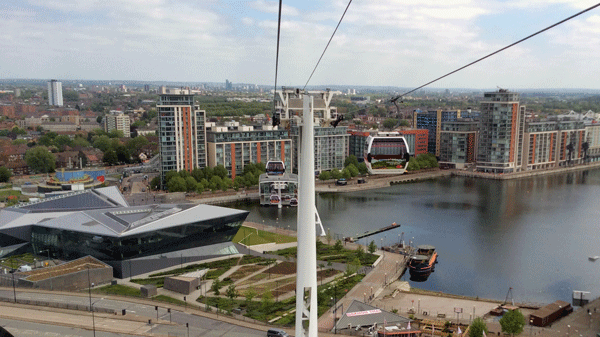Unfortunately, the Emirates Air Line Cable Car in London is once again attracting attention for all the wrong reasons. Most recently, a leading mayoral candidate Sadiq Khan commented that if elected, he would freeze transit fares, allow unlimited bus transfers in a one hour timeframe and terminate public funding for the aerial lift.
While this kind of statement makes for good electioneering, it’s a bit of a red herring. See, the thing is the cable car actually doesn’t receive any subsidies. In fact, as 853blog revealed in December, the cable car actually earns a profit. Since opening in June 2012, the cable car has amassed a surplus of US$1.5mm (£1mm).
Yes, this is a poor financial showing for Wall Street — but we’re not talking about Wall Street. We’re talking about transportation and public transit infrastructure and should analyze and compare this system within that fiscal context. By this measurement, the system is an unqualified success. Nearly all publicly built transportation systems in the Western world, whether it be highways, rail, buses or what not, lose vast sums of money. The Emirates Air Line, meanwhile is profitable.
Marginally so, yes, and likely wouldn’t be without the sizeable sponsorship money endowed upon it. But still, it’s profitable.
Could detractors argue that the cable car money be spent elsewhere? Of course they could. Or that the cable car was incorrectly marketed as a “commuter link” when it was clearly a Toy for Tourists? Definitely. Or perhaps they just don’t like cable cars in general? Sure why not.
But let’s not pretend the system is hemorrhaging money, because it’s not.
Despite annual operating costs of ~US$7.4mm (£5mm), the system is profitable and yet attempts to defame the system continue without end. Now some readers may accuse us of being apologists for the London Cable Car because we happen to be cable car specialists. Fair play.
But let’s remember — we were the first people to (accurately) declare this the most expensive cable car in history and predicted (also accurately) that no commuters were going to use the system. Our track record has been consistent on this system from the beginning.
Even still, Mr. Khan’s stance may be good politics, but it’s dishonest. That’s bothersome.
For us, cable cars happen to be a good idea that’s we’re pleased to see are now catching on worldwide. But as the technology spreads, there is a dire need for responsible and professional analysis that assesses the systems based on their own merits rather than one’s perceived notions of cable car technology — or whether or not you happen to be a fan of a certain Mr. Boris.
If anything, the Emirates Air Line is fascinating case study that offers many important lessons on how cities should, and should not implement urban cable cars and public infrastructure. Aspiring gondola-cities would be wise to pay attention to and learn from its successes and failures.
Given past precedence and the optics of the cable car, it is unlikely that the controversy ends here. But regardless of what happens, we’ll be as excited as anyone else to follow what other bizarre stories are uncovered in the future.

